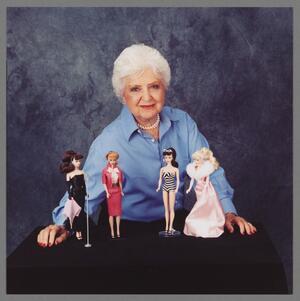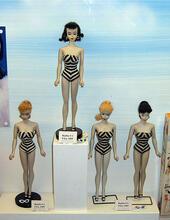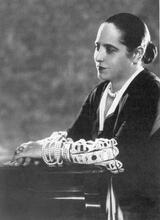Ruth Mosko Handler
Ruth Mosko Handler is best known as the inventor of the Barbie doll, but her most important work may be her prosthetics for survivors of breast cancer. Handler and her husband Elliot started the toy company Mattel in their garage in 1939, designing various toys, negotiating contracts, and running the company collaboratively. In 1959, Handler created the Barbie doll, which she named after her daughter and which proved to be the most popular doll in America, soon followed by the Ken doll, named after her son. Handler’s struggles with cancer in 1970 led to her losing control of the business, and she was forced out in 1975. However, her illness led her to create a new company, Nearly Me, which developed prosthetic breasts for cancer survivors.
Best known as the inventor of the Barbie doll, Ruth Mosko Handler combined her marketing genius with her husband Elliot Handler’s creative designs to form the toy company Mattel, Inc. Starting in their garage in 1939, the Handlers produced Lucite gifts, wooden picture frames, and dollhouse furniture before developing their first toy, the Uke-A-Doodle, in 1947. The success of the Uke-A-Doodle was followed by a series of rubber-belt-driven musical toys, including the Jack-in-the-Box, as well as toy guns such as a Winchester rifle replica. Yet it was the Barbie doll, created in 1959, that “ran off the counter.” Thirty years later, sales of the doll that Handler named after her daughter exceeded one billion dollars.
Early Life and Family
Ruth Mosko Handler, the youngest of ten children, was born in 1916 in Denver, Colorado, to Polish-born parents. Her father, Jacob Mosko, arrived at Ellis Island in 1907. Informing immigration officials that he was a blacksmith, he was sent to Denver, the center of the railroad industry. In 1908, Ida Mosko arrived in America with their six children and joined her husband in Colorado.
Ida Mosko was forty when her youngest child was born, and she became ill soon after. At the age of six months, Ruth was sent to live with her older sister Sarah and Sarah’s husband and stayed with them until she was nineteen. It was in Sarah’s drugstore/soda fountain that she first developed her enthusiasm for business. Ruth preferred work to play, and she grew up in a family where the idea of women working outside of the home was not unusual. In Poland, where antisemitism had fueled impoverished conditions, everyone had had to participate in earning a living. She attributes her family’s entrepreneurial spirit partly to such circumstances.
In 1932, she fell in love with a poor art student named Izzy Handler. Her family was terrified the teenagers would marry. During her sophomore year at the University of Denver, Ruth vacationed in Los Angeles and landed a job at Paramount Studios. Izzy soon joined Ruth in California, and in 1938 the two married in Denver, with her family’s reluctant blessing. Returning to California, Handler encouraged her husband to drop the stereotypical “Izzy” in favor of his middle name, Elliot.
Career Beginnings
Handler returned to her job at Paramount, and her husband enrolled in the Art Center College of Design while working as a lighting fixture designer. He also began to sketch designs for Lucite accessories. Handler encouraged him to produce the pieces and agreed to do the selling. She also negotiated a very large order with Douglas Aircraft: die-cast models of the Douglas DC-3 airplane to be given to corporate customers for Christmas. At the age of twenty-two, the Handlers were in business.
During World War II, President Roosevelt announced that plastics would be restricted to military use. The Handlers had produced a line of plastic picture frames and were in the process of filling a large order. Desperate, they changed the materials to a low-grade wood. The wooden frames were a success, and the order was doubled. That night the Handlers and their colleague Harold “Matt” Matson (whom they had hired as the production expert) celebrated. A name was chosen for the company: “Matt” plus “El” (from Elliot) became Mattel. Although it was Ruth Handler’s idea to make picture frames and her selling was critical in landing the accounts, it never occurred to them that her name should be part of the company name.
In search of a new product, the company decided to follow up on entertainer Arthur Godfrey’s new popularity and the public’s interest in the ukulele. The Handlers created the Uke-A-Doodle and sold eleven million by 1957.
The Handlers were also successful in producing toy guns based on popular television shows. Capitalizing on the western craze, Mattel became a sponsor of a soon-to-debut television show. The Mickey Mouse Club became a hit series, and the fifty-two-week, half-million-dollar investment paid off. By 1958, Mattel sales climbed to fourteen million dollars.
Barbie and Beyond
In 1956, while vacationing in Switzerland, Handler and her fifteen-year-old daughter Barbara became transfixed by a window display of six eleven-inch dolls in different ski outfits. They looked very similar to an idea that Handler had envisioned five years earlier—a child’s doll with an adult body and multiple outfits.
Handler pushed the idea for three years, and in 1959 the Barbie dolls were put on the market. The Ken doll, named for her son, who had been born in 1944, soon followed. By late 1964, the Saturday Evening Post reported that Barbie products supported five thousand workers in Japan, eight hundred workers in California, and numerous press agents and advertising executives. Barbie had a secretary to answer twenty thousand fan letters a week. By 1968, the Barbie Fan Club grew to 1.5 million members in the United States. In 1993, a “second issue” Barbie in its original box was sold at auction for over five thousand dollars.
In 1970, Handler lost a breast to cancer. Because of her illness, she spent less time at Mattel. Her loss of self-esteem affected her leadership, and she lost control of the business. Major decisions had been made without her consent, and by 1973 Mattel was under investigation by the Securities and Exchange Commission. Although Handler and her colleagues pleaded innocent, they were fined, and by 1975 Handler was forced out of the company she had started.
Illness and Legacy
During her unhappy search for an adequate breast prosthesis, she realized that she should be making them for other women. Through her company Nearly Me, she has helped thousands of women. As she explained to a reporter in the early 1980s, “When I conceived Barbie, I believed it was important to a little girl’s self-esteem to play with a doll that has breasts. Now I find it even more important to return that self-esteem to women who have lost theirs.”
Ruth Mosko Handler received numerous awards for her accomplishments in business and philanthropy. Among her honors, she was named Woman of the Year in Business (Los Angeles Times), inducted into the Toy Industry Hall of Fame (Toy Manufacturers of America), received the Volunteer Achievement Award (American Cancer Society), and was the first “Woman of Distinction” of the United Jewish Appeal.
Ruth Handler died on Saturday, April 27, 2002 ,at Century City Hospital in Los Angeles.
Handler, Ruth Mosko. Dream Doll: The Ruth Handler Story (1994).
Lord, M. G. Forever Barbie: The Unauthorized Biography of a Real Doll (1994).






